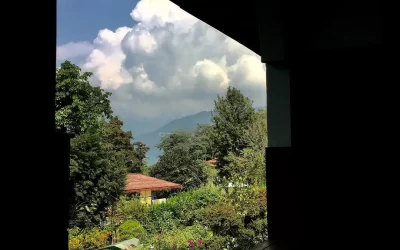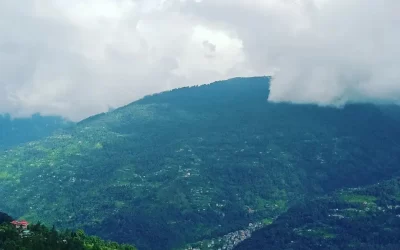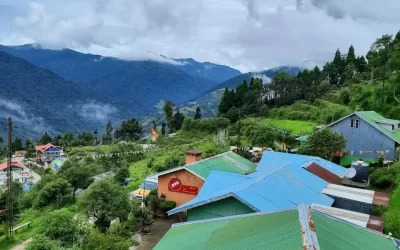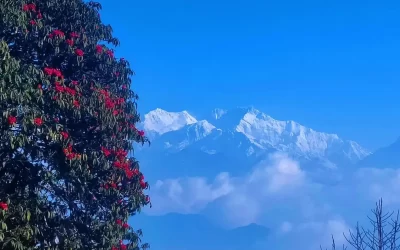Nestled amidst lofty peaks of the Himalayan mountain range, Sikkim is the second smallest and least populous state of India. The mountainous state shares international borders on three sides – Tibet-Autonomous China in the north and northeast, Bhutan in the east, and Nepal in the west, while the Terai-Dooars region of West Bengal sets the southern boundary of Sikkim. Despite its small size, Sikkim is one of the richest states in terms of biodiversity, natural beauty, culture, and heritage. It is also one of the greenest states in the country, having banned the usage of polystyrene products and opting for fully organic agricultural methods.
The beautiful state is a crowning glory of the Eastern Himalayas, being home to the highest peak of the country and third-highest peak of the world, the absolutely stunning Mount Kanchenjunga, also pronounced as Khangchendzonga. From the populated Lower Himalayan plains down south, the landscape of the state merges into lush subtropical woodlands of Kanchenjunga National Park and then rises in the north to the towering, magnificent, snow-crowned peaks of Eastern Himalayas. Scattered amidst this geography lies 28 mountain peaks, 80 glaciers, and 227 high-altitude lakes, many of which are popular tourist attractions around the year. Gangtok, the beautiful capital of Sikkim since 1894, receives throngs of travelers every year, both from within the country and outside.
Sikkim is known for many things – numerous Hindu shrines and Buddhist monasteries, infinite natural beauty amidst snow-clad peaks, misty valleys and green sprawls, myriad of local craft and cuisines to pick from, scores of inspiring trekking trails, endless options in adventure activities – the list goes on and on. But the best thing about Sikkim is perhaps its people, and the warm-hearted hospitality they extend to everyone – locals and tourists alike.
History of Sikkim
The ancient history of Sikkim dates back to the 8th century. The patron saint of Sikkim, Sri Padmasambhava, also known as Guru Rinpoche, is believed to have walked through the land in that era and blessed the region with the introduction of Buddhism. The earliest residents of the region are Lepcha, Limbu, and Magar communities. The moniker ‘Sikkim’ comes from a combination of two Limbu words – ‘su’ meaning ‘new’ and ‘khyim’ meaning ‘house’. Other names of the region are ‘Nye-mae-el’ meaning ‘paradise’ given by the Lepcha people, and ‘Beymul Demazong’ meaning ‘Hidden valley of rice’ given by Bhutia people.
Phuntsog Namgyal from the Bhutia community was crowned as the first ‘chogyal’ – spiritual and temporal monarch – in 1642. The Namgyal dynasty ruled over Sikkim for generations to come. They fought off numerous territorial attacks from Nepal from the east and Bhutan from the west during their tenure. During the British Rule, Sikkim first became a de-facto protectorate of the Empire in the early 19th century and were supported by the Royal Army during altercations with neighboring states. Conflicts in later years led to Sikkim being included as a princely state under the British rule.
The monarchy was overturned two years after India’s independence in 1947. A special referendum was held in 1974 where 97 percent electorate voted in favor of the merger with India. Sikkim became the 22nd state of India on May 16, 1975.
Traditional Food and Cuisine of Sikkim
Both Nepalese and Tibetan cuisine has an immense influence on the palate of Sikkim. The staple food of the state are rice, dal, and everyday curries. But when it comes to delicacies, one dish easily takes the cake for being the most popular – momos. The flour dumplings filled with meat and vegetables, steamed or fried, and accompanied with chili sauce and hot clear soup, has become a phenomenon all over South Asia. The next most popular dish is the Thukpa or Gya-thuk, which is a preparation of noodle soup with meat, eggs, chopped vegetables, and a dash of garlic for great taste. One can find both these dishes almost everywhere in Sikkim, from roadside shacks to luxurious restaurants.
But there is more to Sikkimese cuisine than momo and Thukpa. Phagshapa is a culinary delight, which is a dish of pork strips served with rice and radishes. Gundruk and Sinki is fermented vegetables cooked in spices, making it a healthy yet delicious dish. If you are a bread enthusiast, the Sael Roti is a must-try. They are rings of fried fermented rice batter served with curry or just by itself. Fermentation is a common theme in Sikkimese recipes, as it makes yet another appearance in the famous Kinema curry. The dish is made with fermented soybean cooked in a curry of tomato, red chili, onion, and turmeric.
No visit to Sikkim is complete for a foodie without experimenting with the ever-popular Bamboo Shoot Curry. The staple delicacy of Sikkim takes meat, preferably pork, and cooks it inside a fresh bamboo shoot to produce scrumptious Tama Curry. Like any other mountainous region, Sikkim too has its own local alcohol. Chang, made from fermented millet, is the native choice of poison and you can find it anywhere in Sikkim served in bamboo glasses. If you still have some culinary curiosity left, try out Sha Phaley, Thenthuk, Kodo ko Roti, and Churpi with Niguru.
Sikkim Tourism
Sikkim offers a holiday experience which is an assortment of culture, cuisine, heritage, adventure, and boundless natural beauty. For anyone who loves a vacation that nourishes the heart and soul, Sikkim is the ideal destination. The places which get the highest number of tourist footfall in Sikkim are Gangtok, Pelling, Yumthang, Yuksom, Ravangla, Lachung, Lachen, and Varsey.
Perched on the right shoulder of the country’s map, the mesmerizing landscape of Sikkim offers lofty East Himalayan peaks, lush alpine meadows, beautiful streams and waterfalls, pristine high altitude lakes, and fulfilling trekking trails connecting the places like synapses. Much of Sikkim is claimed by the untouched wilderness of Himalayan forests and therefore under the Khangchendzonga National Park or one of the seven wildlife sanctuary of the state. One can explore the abundance of endemic flora and fauna in these places or indulge in an exciting adventure like mountaineering, river rafting, yak rides, paragliding, mountain biking, trekking, hiking, bird watching, cable car rides, and overnight camping.
Tourism in the urban areas, on the other hand, feature exploring the sacred religious sites and discovering the art, culture, and food of Sikkim. Blessed by the patron saint Guru Padmasambhava, the state is home to more than 200 different Buddhist monasteries – each with a history and importance of its own. Some of the most visited ones are Rumtek, Pemayangtse, Tashiding, Ralang, Phodong, and Enchey.
Best time to visit Sikkim
The ideal time to visit Sikkim is during the summer season between the months of May and June. Being a Himalayan state, the summers in Sikkim are not as harsh as the rest of India. Weather remains pleasant and soothing with temperature ranging from 10-25 degrees Celsius on average. The rhododendrons and other flowers are also in full bloom during summer.
The monsoons from July to October brings out the greenery in the slopes. But the rains make the terrains muddy and slippery, and therefore dangerous for traveling. There are also risks of landslides and road blockage, leading to sudden and forced changes in the itinerary.
The winter season between November to February is once again charming, with lovely snowfall and chilled weather. But certain long route trek routes might be closed down due to snow accumulation. Temperature ranges between sub-zero levels to 7-8 degrees Celsius. So if you are comfortable with nipping cold and willing to put on double layers, winter is perfect for exploring the beauty of Sikkim.
How to reach Sikkim
Sikkim is well connected with the rest of India via all modes of transportation. Not every part of the state is accessible by motor for obvious reasons, but the main settlements have easy and hassle-free road communication.
Airway
The nearest airway access to Sikkim is Bagdogra Airport near Siliguri town of West Bengal, 126 km away from Gangtok. Several Indian air carriers such as SpiceJet, IndiGo, Air Asia, and Vistara run regular flights from important Indian cities like Kolkata, Mumbai, New Delhi, Bangalore, etc. There are options for both non-stop and connecting flights. From the airport, there are bus, cab, and shuttle services to take you to the city of Gangtok.
There is also a helicopter service from Bagdogra to Gangtok which operates only once a day, carries four people, and takes around 20-30 minutes to reach the helipad at Gangtok. This service, however, is subject to weather conditions.
Sikkim got its first and only airport at a town called Pakyong, 31 km away from the state capital Gangtok. But due to several issues with visibility and infrastructure, the Pakyong Airport had stopped operations in June 2019 and is yet to resume service.
Railway
The nearest railhead to Sikkim is in West Bengal as well. The two major stations connecting Sikkim with the rest of India are Siliguri Junction, 114 km away and New Jalpaiguri Junction, 125 km away. Hired taxis and bus services are available from both the places to get you to Sikkim. The state is slated to get its own railhead as the New Sikkim Railway Project commenced to set up the Rangpo station connecting Sikkim with Sevoke, West Bengal. But the project is on hold for the moment.
Roadway
The lifeline of Sikkim transportation is the National Highway 10, formerly NH 31A, which connects several locations of Sikkim with Siliguri. The majority of the state’s incoming and outgoing traffic goes through this route. S.N.T operated buses, private Volvo services, private cars, hired taxis, shared jeeps – all follow this beautiful 4-hour route with the glistening Teesta River on one side and Eastern Himalayan peaks on the other. There are roadway connections from other tourist destinations like Darjeeling, Kalimpong, and Kurseong as well. Sikkim is further connected with Tibet-China by the Nathu La pass.
Districts in Sikkim
Sikkim is divided into four districts geographically – East, West, North, and South. They are further divided into several smaller subdivisions.
1. East Sikkim
East Sikkim is the most populous part of the state. The capital of this district is Gangtok, which is also the state capital. East Sikkim is easily the most happening district of the state, as well as the hub of all administrative and economic activities. But other than the buzz of the capital city, East Sikkim is also home to the beautiful Tsongmo Lake, a number of monasteries including the famous Rumtek Monastery, Himalayan Zoological Park, Tashi View Point, and the sensational Nathu La Pass and Baba Mandir.
2. West Sikkim
West Sikkim offers a combination of rich history and exquisite trekking locations. The capital of the district is Geyzing or Gyalshing. Pelling and Yuksom are the other important towns here to visit. Yuksom is the place where the very first Chogyal of Sikkim was consecrated way back in 1642 and the first monasteries of Sikkim, Dubdi, and Sanga Choling, were established. Yuksom remained the capital of the Namgyal dynasty for 50 years before it shifted to Rabtense.
Khecheopalri Lake, Tashiding Monastery, and Pemayangtse Monastery are popular tourist destinations of the district. West Sikkim is also home to parts of the Khangchendzonga National Park, the rest of which falls in North Sikkim. The presence of the protected forests offers up several mind-blowing trekking trails here for the adventurous, such as the Varsey Rhododendron trek, Goecha La trek, Yuksom Dzongri trek, and Kanchenjunga Falls trek.
3. North Sikkim
North Sikkim is the largest of the four districts of the state. Mangan is the district headquarter and also the most populous part of North Sikkim. Due to the sharing of sensitive borders with China, the district is heavily patrolled by the Indian Army. Entry to tourists is restricted in most areas and only allowed by authorized permits. Despite the obstacles, North Sikkim is one of the most visited zones due to its abundant beauty. The district is home to part of Khangchendzonga National Park and the Shingba Wildlife Sanctuary. The landscape features lush green fields and throngs of wildflowers, including rhododendron. Yumthang, Gurudongmar Lake, Crow’s Lake, Tso Lhamo Lake, Zemu Glacier, Lachung Monastery, Phodong Monastery, and Zero Point are some of the exciting destinations to explore in North Sikkim.
4. South Sikkim
South Sikkim is the smallest of the districts. It is the most industrialized one as well, owing to the availability of flat and stable land. The headquarters is located at Namchi. Ravangla, Jorethang, and Melli are the other major towns of the district. The district is known for Sikkim Tea grown extensively at Temi Tea Garden. Located near Namchi is the Samdruptse Hill, which is the site of the 135 feet tall statue of Sikkim’s patron saint Guru Padmasambhava. Other places to visit are Tathagata Tsal Buddha Park, Char Dham Temple, New Ralang Monastery, and the twin hills of Tendong and Maenam which are of mythological importance to Lepcha and Bhutia people.









